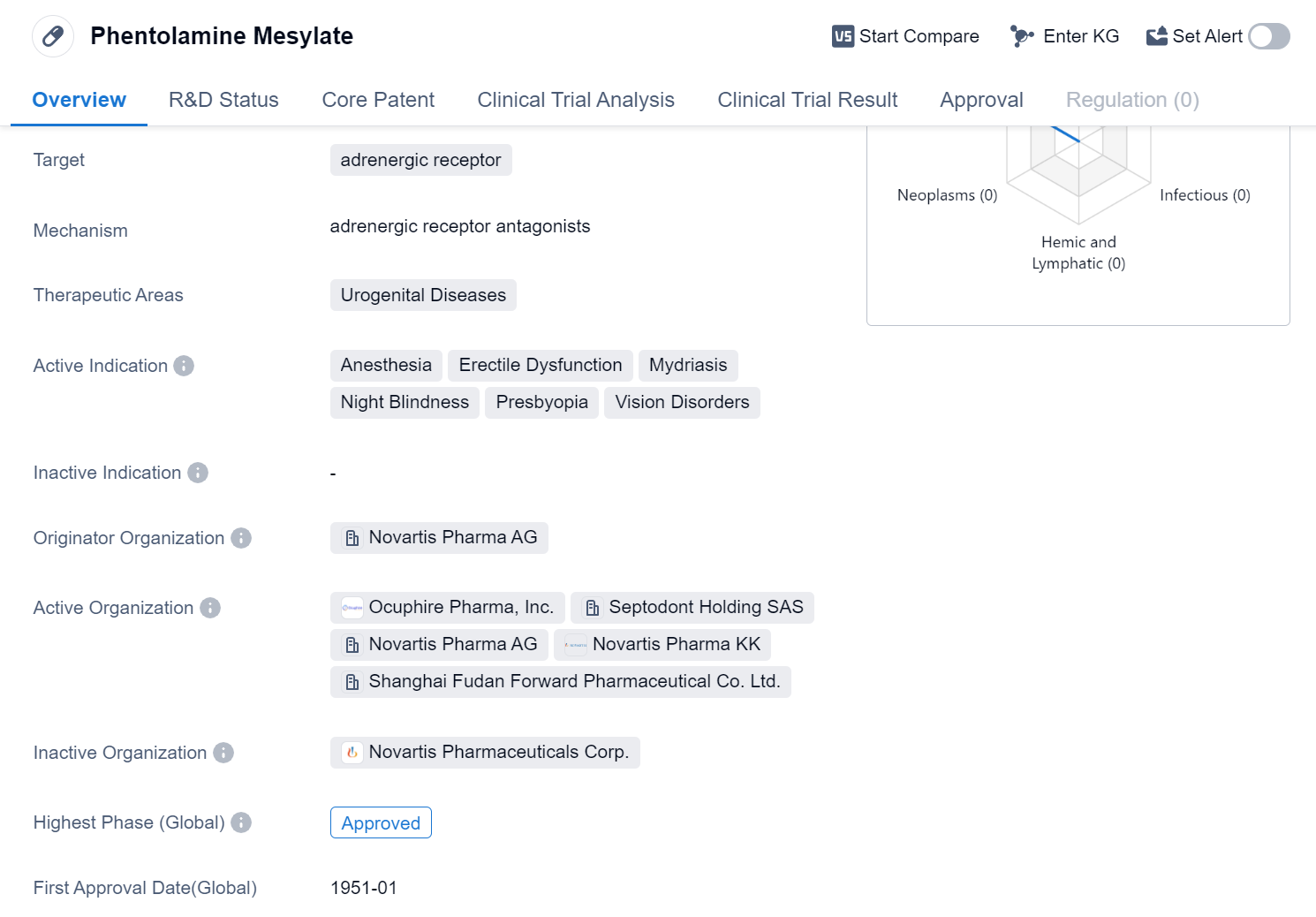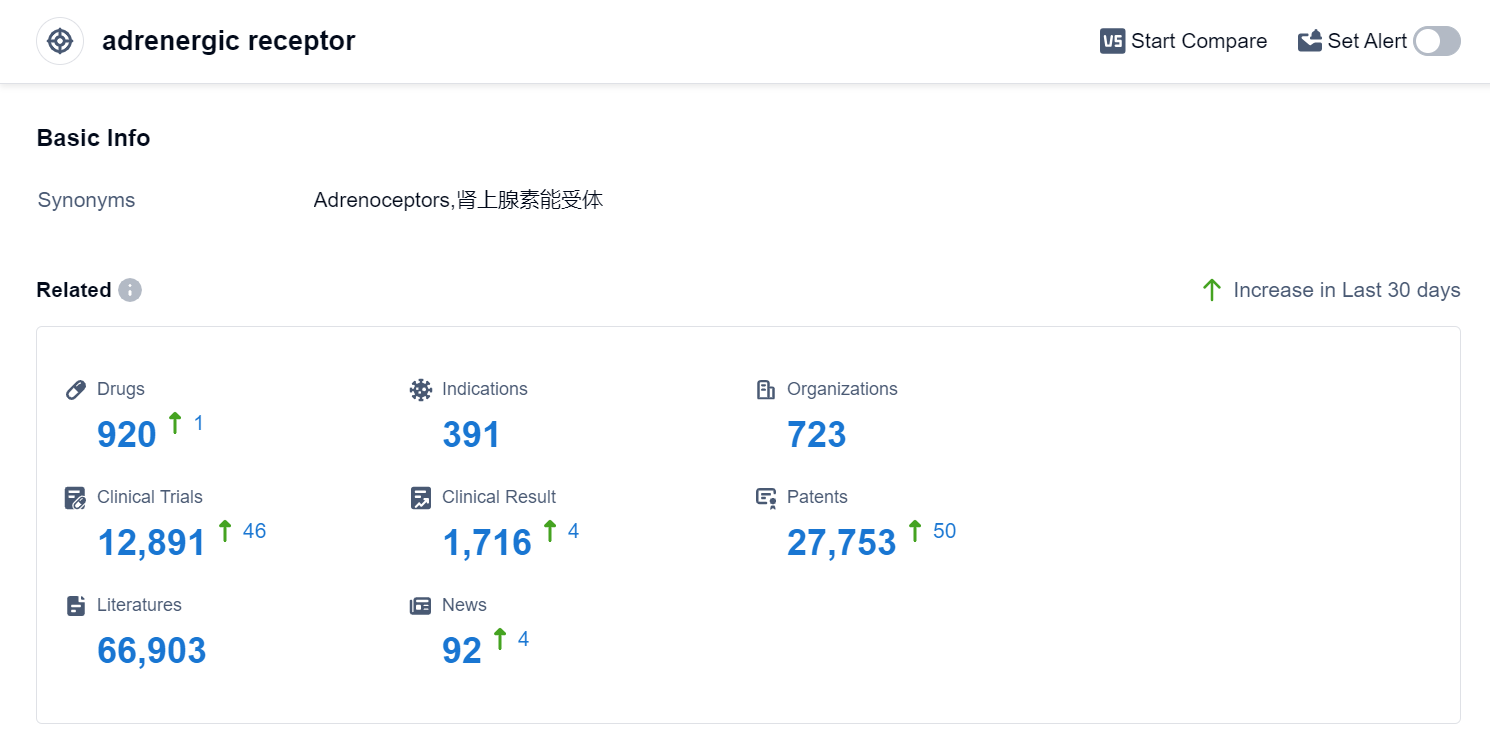Exploring Phentolamine Mesylate's Revolutionary R&D Successes
Phentolamine Mesylate's R&D Progress
Phentolamine Mesylate is a small molecule drug that targets the adrenergic receptor. It is primarily used in the treatment of urogenital diseases. The drug has multiple active indications, including anesthesia, erectile dysfunction, mydriasis (pupil dilation), night blindness, presbyopia (age-related farsightedness), and vision disorders.
The originator organization of Phentolamine Mesylate is Novartis Pharma AG, a renowned pharmaceutical company. The drug has achieved the highest phase of approval globally. The global first approval date for Phentolamine Mesylate was in January 1951.
Phentolamine Mesylate's approval for anesthesia suggests its use as a local anesthetic agent. It is commonly used in dental procedures and surgeries to numb specific areas. Additionally, the drug's approval for erectile dysfunction highlights its potential role in improving sexual function by increasing blood flow to the penis.
The drug's approval for mydriasis indicates its use in ophthalmology for dilating the pupil. This can aid in eye examinations and certain surgical procedures. Furthermore, Phentolamine Mesylate's approval for night blindness and vision disorders suggests its potential in treating conditions that affect vision, although further details on specific indications are not provided.
As a small molecule drug targeting the adrenergic receptor, Phentolamine Mesylate likely exerts its therapeutic effects by blocking the action of certain neurotransmitters involved in the sympathetic nervous system. This mechanism of action may contribute to its efficacy in the treatment of urogenital diseases and its various active indications.
👇Please click on the image below to directly access the latest data (R&D Status | Core Patent | Clinical Trial | Approval status in Global countries) of this drug.
Mechanism of Action for Phentolamine Mesylate: adrenergic receptor antagonists
Adrenergic receptor antagonists, also known as adrenergic blockers or adrenergic antagonists, are a class of drugs that block the effects of the neurotransmitters norepinephrine and epinephrine (adrenaline) on adrenergic receptors in the body. These receptors are found in various tissues and organs, including the heart, blood vessels, lungs, and smooth muscles.
From a biomedical perspective, adrenergic receptor antagonists are commonly used in the treatment of conditions such as hypertension (high blood pressure), angina (chest pain), arrhythmias (irregular heart rhythms), and heart failure. By blocking the adrenergic receptors, these drugs reduce the effects of sympathetic nervous system activation, leading to decreased heart rate, vasodilation (widening of blood vessels), and relaxation of smooth muscles. This helps to lower blood pressure, improve blood flow, and reduce the workload on the heart.
There are different subtypes of adrenergic receptors, including alpha and beta receptors. Adrenergic receptor antagonists can be further classified based on their selectivity for these receptor subtypes. For example, selective beta blockers primarily block beta receptors, while non-selective beta blockers block both beta and alpha receptors.
It's important to note that adrenergic receptor antagonists should be used under medical supervision, as they can have various side effects depending on the specific drug and individual patient factors. Some common side effects include dizziness, fatigue, low blood pressure, and sexual dysfunction.
Drug Target R&D Trends for Phentolamine Mesylate
According to Patsnap Synapse, as of 11 Sep 2023, there are a total of 920 adrenergic receptor drugs worldwide, from 723 organizations, covering 391 indications, and conducting 12891 clinical trials.
The analysis of the target adrenergic receptor reveals a competitive landscape with multiple companies actively involved in research and development. Novartis AG, GSK Plc, AstraZeneca PLC, Pfizer Inc., and Sanofi are the leading companies with a significant number of approved drugs and ongoing research. Hypertension and asthma are the most common indications for approved drugs targeting the adrenergic receptor. Small molecule drugs dominate the drug type analysis, indicating intense competition and continuous research in this area. China, the United States, and Japan are the leading countries in terms of drug development, with China having the highest number of approved drugs. Overall, the target adrenergic receptor presents a promising area for future development and therapeutic interventions in various diseases.
👇Please click on the picture link below for free registration or log in directly if you have a freemium account, you can browse the latest research progress on drugs, indications, organizations, clinical trials, clinical results, and drug patents related to this target
Conclusion
In summary, Phentolamine Mesylate is a small molecule drug developed by Novartis Pharma AG. It targets the adrenergic receptor and is primarily used in the treatment of urogenital diseases. The drug has multiple active indications, including anesthesia, erectile dysfunction, mydriasis, night blindness, presbyopia, and vision disorders. With its long history of approval since 1951, Phentolamine Mesylate has established itself as a valuable therapeutic option in the field of biomedicine.






